ZZ Plant | Care Difficulty – Easy

 Add to favorites
Add to favorites
Unique plants are eye-catching plants…and the ZZ plant falls right into that category. When I first started collecting indoor houseplants, this was one that I snatched up. I own two of them, and they haven’t caused me any issues. They don’t talk back, miss curfew, or refuse to flaunt their beauty. They have a unique, eye-catching shape that is loaded with a dense cluster of glossy zig-zag leaves. The leaflets are so shiny it looks as if the plant has been sprayed with leaf polish.
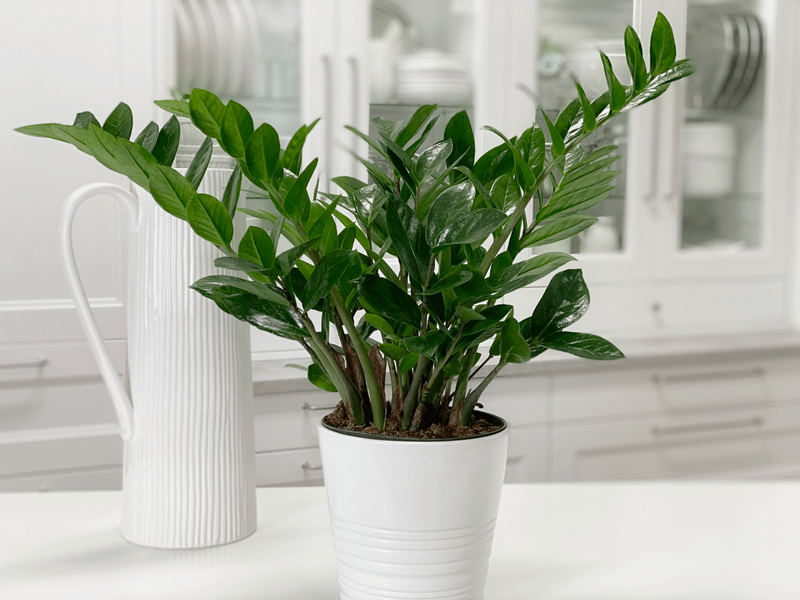
ZZ plants are drought tolerant, can handle dry air, and will be happy in low-light conditions. If given bright indirect light, they will shoot out new growth. And trust me, new growth on this plant is exciting to experience. Like a succulent, the thick stems and bulbous roots store water, making it the perfect houseplant for the traveler or workaholic. They are slow-growing plants that reach up to three to five feet — patience, my friend, patience. If you are short in the patience department, purchase a more substantial plant from the get-go!
ZZ plants are rhizome plants and also known as Zanzibar Gem, Zuzu plant, aroid palm, eternity plant, emerald palm, Zamioculcus zamiifolia, and Zamioculcus zamiifolia ‘Zenzi.’ It’s no wonder that it can be challenging to remember the names of plants and why there is such confusion when people talk about them.
Light Requirements
ZZ plants are happy in low-light conditions, but the brighter the indirect light is, the better. To provide indirect light, place the plant a few feet away from a sunny window, in front of a window covered with a sheer curtain, or in front of a window with a northern exposure.
I own two of these plants. One is high up on a shelf in my studio, which doesn’t get much indirect light; instead, the room is flooded with fluorescent lighting, and it is flourishing. My other ZZ plant sits in the center of our living room on the coffee table. It gets indirect light from a northern window. It, too, is doing super well.
Water Requirements
Water only when the soil is completely dry. Remember that the thick stems and bulbous roots store water, so you actually have to worry about overwatering rather than underwatering. Problems can develop if the plant is watered too frequently and the potting soil is constantly wet.
Optimum Temperature
They prefer average to warm temperatures of 55-85 degrees (F), which is way better than me. I have a much narrower window of temperature tolerance. I am a happy camper around 65 degrees (F)… just in case I visit, you know where to stick me. Haha. Avoid cold drafts and heat vents.
Fertilizer – Plant Food
Fertilize twice during the growing season (spring-fall) with a 1/2 strength diluted complete fertilizer. These plants do not like to be fertilized often. If you overfeed a plant, you can remove the houseplant from its current soil and repot it in fresh soil. This technique is undoubtedly the best way to get rid of the excess nutrients affecting your plant. Alternatively, you can flush the soil, which involves drenching the soil with water and letting it drain out. Repeat this several times to help the soil get rid of excess fertilizer.
Additional Care
- Remove any dead, discolored, damaged, or diseased leaves and stems as they occur with clean, sharp scissors.
- Clean the leaves often enough to keep dust off of them. Do not use a feather duster, which increases the chances of spreading pests between plants.
- Avoid using commercial leaf shining products on this plant.
- When potting, a good ratio is : 3 parts potting soil, 1 part succulent & cactus mix, & 1 part coco coir.
Plant Characteristics to Watch For
Diagnosing what is going wrong with your plant is going to take a little detective work, but even more patience! First of all, don’t panic and don’t throw out a plant prematurely. Take a few deep breaths and work down the list of possible issues. Below, I am going to share some typical symptoms that can arise. When I start to spot troubling signs on a plant, I take the plant into a room with good lighting, pull out my magnifiers, and begin by thoroughly inspecting the plant.
The leaves are yellowing and falling off.
- This happens when the plant is being overwatered.
- Stop watering and let the soil dry out. Once the soil is dry, saturate the soil with water, allowing the excess water to drain out of the pot. Continue this watering process… remember, the stems and root bulbs hold extra water.
- Re-evaluate your watering practices if a single stem suddenly withers, and all the plant’s leaves turn yellow.
There are yellow markings on the leaves.
- This can be a sign of aphids attacking your plant.
- Solution: See below for common plant pests
The leaves are drying out and look scorched.
- Too much direct exposure to the sun can cause scorched or dried-out leaves.
- Solution: Move your plant to a shadier location until its leaves start to resemble their normal, green state.
Leaf tips turning brown.
- The cause is likely dry air and low humidity.
- Solution: Add a humidifier to the room.
My plant isn’t growing.
- ZZ plants do really well in low light conditions, but like most plants, they will grow faster when they are exposed to more indirect light.
- Solution: Move the plant to an area that receives bright indirect light.
Uneven growth.
- A ZZ plant will grow and lean toward light sources.
- Solution: Be sure to rotate the pot every once in a while to encourage an evenly spread plant. I do this when I water my plants.
Leggy stems.
- If light conditions are poor, the stems can become spindly, leggy, or stretched and much longer than normal.
- Solution: Consider relocating the plant to a brighter location.
Common Bugs to Watch For
The ZZ plant is very seldom seen to suffer from pests or disease. But there are a few that they can come in contact with. If you want to have healthy houseplants, you MUST inspect them regularly. Every time I water a plant, I give it a quick look-over. Bugs/insects feeding on your plants reduces the plant sap and redirects nutrients from leaves. Some chew on the leaves, leaving holes in the leaves. Also watch for wilting or yellowing, distorted, or speckled leaves. They can quickly get out of hand and spread to your other plants.
-
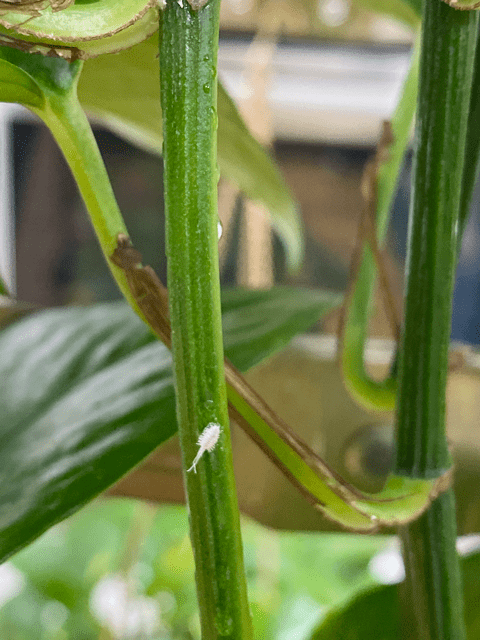
-
Mealybugs
-
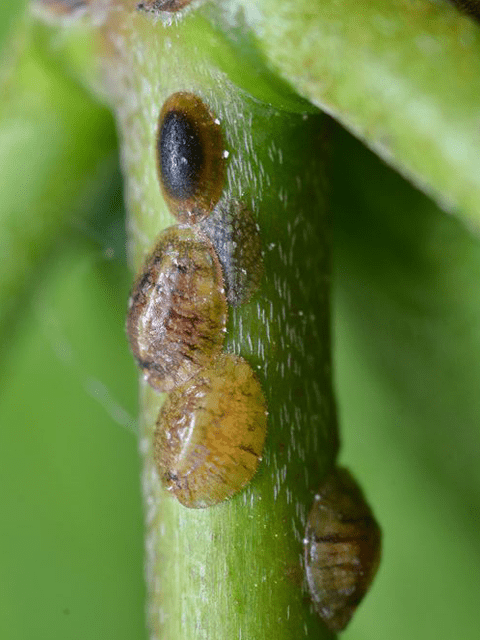
-
Scales
-
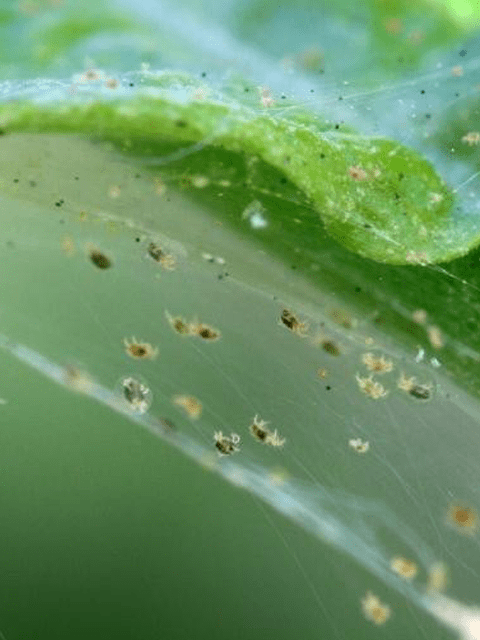
-
Spider mites
- Mealybugs look like small balls of cotton. They can travel, slooooooowly, but they have a strong will and determination! Though they are slow-moving, if any plant is touching another, there is a chance the mealybug will hitch a ride on a new leaf and spread. They breed like rabbits of the insect world. Females can deposit around 600 eggs in loose cottony masses, often on the underside of leaves or along stems.
- Scales are dark-colored bumps that are primarily immobile insects that stick themselves to stems and leaves. They are rather inconspicuous and don’t look like a typical insect. They can range in color but are most often brownish in appearance. They’re called “scales” primarily due to their scale-like appearance on a plant, due to waxy or armored coverings. They are often seen in clumps along a stem, sucking away at the plant’s juices with their spiky mouthpart.
- Spider mites are more common on houseplants. They are not insects – they are related to spiders. These appear to be tiny black or red moving dots. Spider mites are nearly invisible to the naked eye. You often need a magnifying lens to spot them, or you may just notice a reddish film across the bottom of the leaves, some webbing, or even some leaf damage, which usually results in reddish-brown spots on the leaf.
Toxicity
You should take care when handling this plant because it contains calcium oxalate crystals, which can cause skin irritation or more severe ailments like stomach pain. The oxalate crystals make the plant especially poisonous for cats and dogs, so make sure to keep it out of reach. ZZ plants are still safe to have in your home as long as you keep them out of reach from curious pets and children. You should wash your hands immediately after tending to your plant or wear gloves to minimize contact with the plant.
© AmieSue.com
Tags: Care Difficulty - Easy, Low Light, Toxic to Pets and Humans


 Add to favorites
Add to favorites

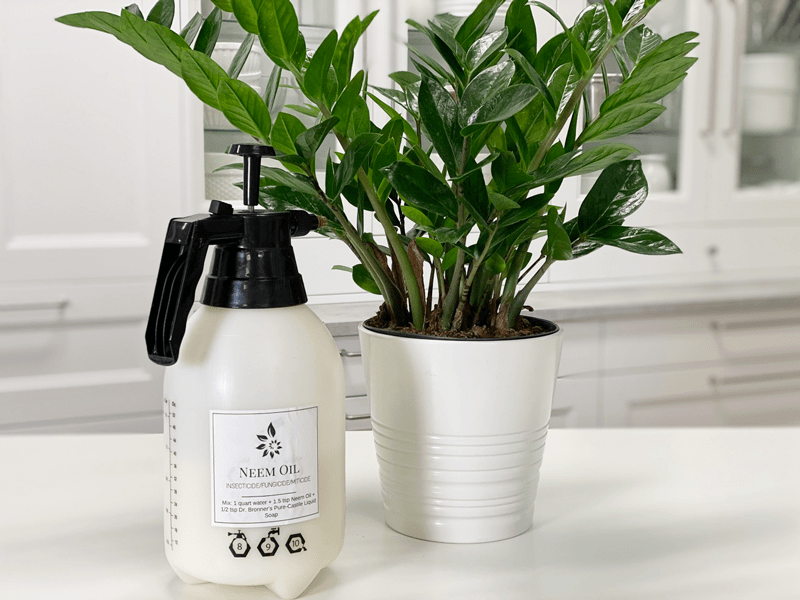
Is care for the Raven ZZ any different than the regular ZZ?
Good afternoon,
I treat them the same way. Enjoy! amie sue
I love the light that you have in the picture titled “Master list of houseplant troubleshooting”. Do you remember where you purchased? Also, I love your articles.
Hi Judy,
I purchased it many years ago at Home Goods. I am happy to hear that you are enjoying the site. Have a wonderful day, amie sue
my zz plant is very large and beautiful. I just noticed some dark areas on some stems. what could this be , and what to do. thanks
Hello Karen,
Dark spots can be an indicator of overwatering. amie sue
My zz plant lost all its leaves. The stems (6 of them) are still green. It has been about 2 months, but still no leaves. What can I do?
Oh my Terry, I am sorry to hear that. I don’t really know what would cause that, there are so many factors. But the first thing that comes to mind is that it most likely indicates severe underwatering; shedding of the leaves is a survival mechanism to reduce water loss, and the stems are still healthy because they can store some water within them.
Extreme temperature changes, too low of light, and the watering schedule are things that can cause leaf drop. I would water the plant, until water drains from the drain holes in the pot. If your plant doesn’t have drain holes, I would repot into one that does. The monitor the soil, keeping it moist but not wet. Remember, watering needs change depending on the climate. Less water in the winter and more water in the summer.
I hope this helps, amie sue
[…] © Nouveau Raw […]
[…] © Nouveau Raw […]